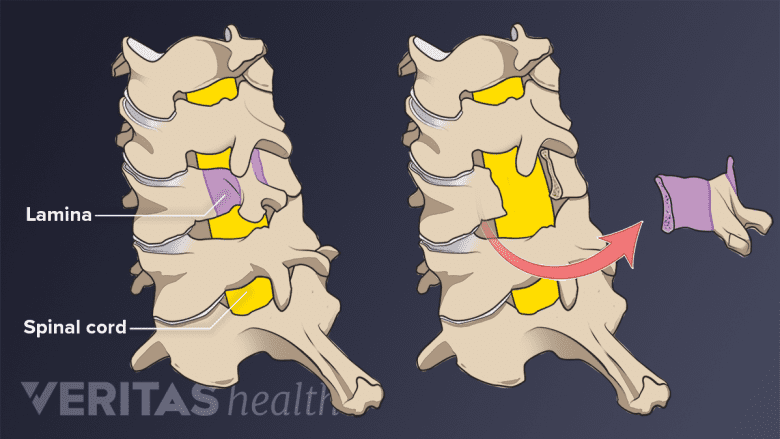Neck surgery may be an option if you find that nonsurgical treatments have not relieved your pain and/or neurological symptoms.
Surgery may be recommended sooner if you have spinal cord or spinal nerve root compression.
When Neck Surgery may be Recommended
Surgery to relieve neck-related pain is typically performed for one or more of the following reasons:
- To decompress a nerve root (by removing a damaged disc and/or other problematic structure)
- To decompress the spinal cord
- To stabilize the cervical spine
Surgery is not likely to be recommended if imaging and diagnostic tests cannot confirm the anatomical cause of one of the above issues.
In This Article:
- All About Neck Pain
- Neck Pain Symptoms
- Neck Pain Causes
- Treatment for Neck Pain
- Surgery for Neck Pain
- Neck Pain Causes Video
Common Types of Surgery for Neck Pain
The two most common surgery options for neck pain are designed to remove a damaged disc and restore normal spacing within the vertebral level to decompress a nerve root and/or the spinal cord.
Anterior Cervical Discectomy and Fusion (ACDF)
The most common cervical spine surgery is ACDF, which is a combination of two surgeries done at the same time:
- Discectomy. The surgical removal of the damaged disc
- Fusion. A cervical spinal fusion, which sets up the conditions for the bone to grow across the space where the disc was an create a strong stable segment with no motion
An ACDF surgery is performed through the front of the neck, which is called an “anterior” surgical approach.
Less commonly, the surgery may be approached through the back of the neck, called posterior cervical decompression or microdiscectomy. In this case, only part of the disc is removed, and no spinal fusion is needed. The location of the cervical disc herniation must be accessible with minimal manipulation of the spinal cord. If the location is too central, it is safer to use the ACDF approach.
Cervical Artificial Disc Replacement (ADR)
Another surgery is the surgical removal of the disc and replacement of the damaged disc with an artificial disc implant.
Compared to ACDF, a potential benefit of cervical disc replacement is that it retains more natural neck mobility. As a somewhat newer method, however, it is not as common as ACDF and longer-term outcomes are still being studied.
ACDF is still considered the gold standard for neck pain surgery, but cervical ADR is also a popular option. In some cases, such as when advanced spinal degeneration is present, ACDF may still be an option but not a cervical artificial disc.
Other Surgical Options for Spinal Decompression

Laminectomy is a decompression surgery that helps preserve motion in the neck.
Sometimes other surgical options may be used instead of or in conjunction with a discectomy to help relieve signs and symptoms related to cervical nerve root or spinal cord compression.
- Posterior cervical laminectomy is done through the back of the neck and involves the removal of a lamina, which is the back part of a vertebra. A potential advantage a posterior laminectomy is that more flexibility in the neck can be retained if a spinal fusion can be avoided. Sometimes spinal fusion is still done in conjunction with laminectomy.
- Posterior cervical laminoplasty is like the laminectomy, except the lamina is not completely removed. Rather the lamina is cut and restructured to make more space in the spinal canal.
- Posterior cervical foraminotomy is performed through the back of the neck and a small part of the foramen is removed. If a nerve is irritated by a herniated disc, the surgeon might remove part of the disc. If a nerve is irritated by a bone spur, the surgeon chisels away that bone spur. No spinal fusion is needed.
- Anterior cervical corpectomy is like anterior cervical discectomy, except that it involves the removal of at least one vertebral body (the cylindrical bone at the front of a vertebra) along with the adjacent discs above and below that vertebra. An anterior cervical corpectomy is a specialized surgery that is usually only done if there is spinal cord compression at multiple spinal levels.
Spinal Cord Stimulation
If an ACDF or other type of common neck surgery does not relieve the patient’s pain, a spinal cord stimulator may be considered to interrupt the pain signals prior to reaching the brain.
With this type of surgery, a trial is first performed prior to implanting the spinal cord stimulation device.
Neck Pain Surgery Risks
Like all surgery, neck surgery carries potential risks and complications, such as infection, allergic reaction, excessive bleeding. Paralysis is a rare but serious risk because the spinal cord is housed in the cervical spine.
If a surgical solution is considered, all appropriate nonsurgical options must have been exhausted, the patient is considered a good surgical candidate, and the surgeon has reviewed the risks, benefits and alternatives of surgical treatment with the patient as well as answering all questions.
Editor’s Top Picks
- Anterior Cervical Discectomy and Fusion (ACDF) Video
- Cervical Disc Replacement Surgery Video
- Artificial Disc Vs. Anterior Cervical Discectomy and Fusion
- Surgical Options for Cervical Radiculopathy from a Herniated Cervical Disc
- Anterior Cervical Corpectomy Spine Surgery
- Anterior Cervical Discectomy and Fusion Complications

